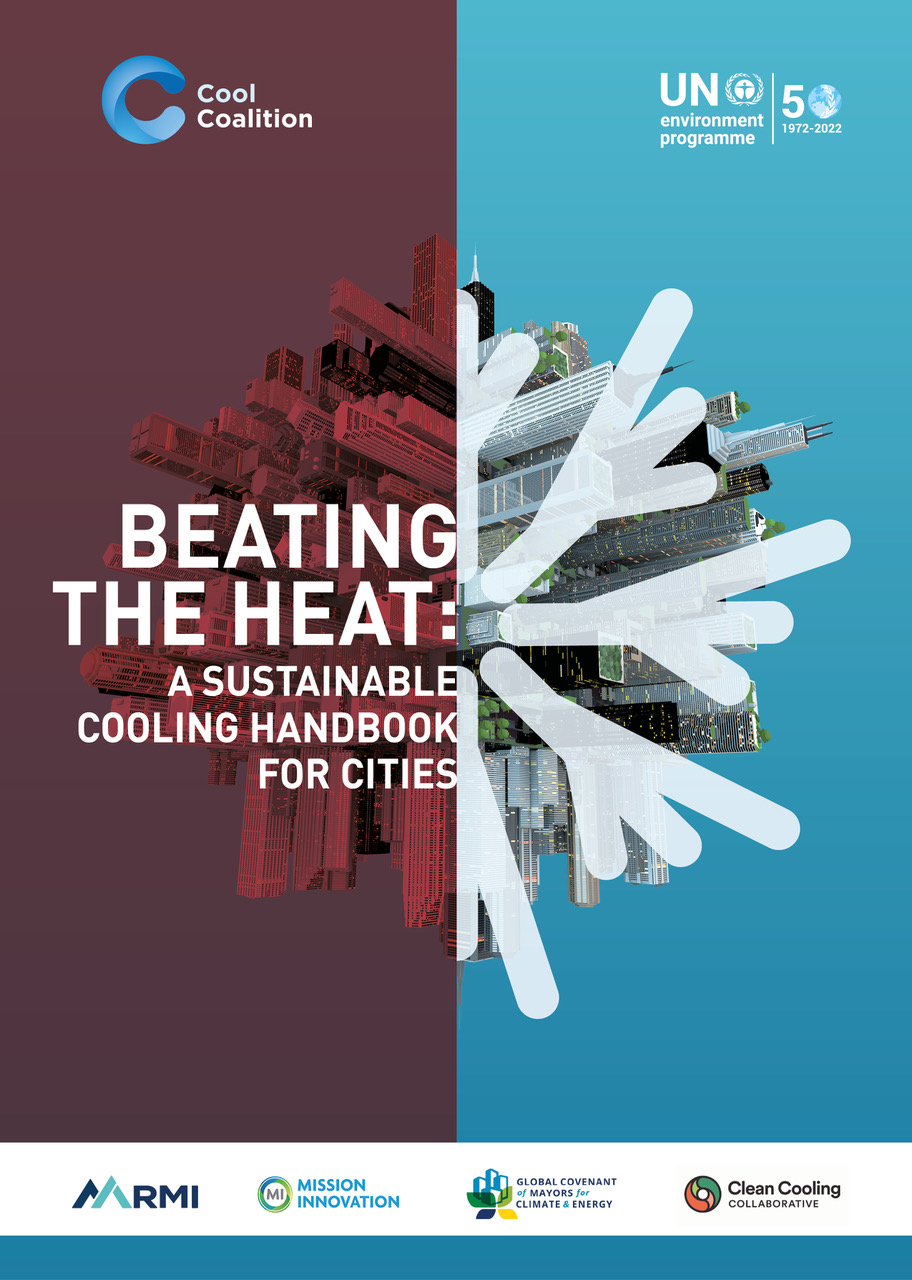by Brianna Crandall — December 13, 2021 — The United Nations Environment Programme (UNEP) recently published detailed guidance to help the world’s cities address warming, which UNEP says is occurring at twice the global average rate in urban areas.
 Beating the Heat: A Sustainable Cooling Handbook for Cities, prepared with RMI, states that by the end of this century, many cities could warm as much as 4°C if GHG emissions continue at high levels. Even at 1.5°C of warming, 2.3 billion people could be vulnerable to severe heat waves.
Beating the Heat: A Sustainable Cooling Handbook for Cities, prepared with RMI, states that by the end of this century, many cities could warm as much as 4°C if GHG emissions continue at high levels. Even at 1.5°C of warming, 2.3 billion people could be vulnerable to severe heat waves.
Launched at the ongoing UN Climate Conference (COP26) by the Cool Coalition, UNEP, RMI, the Global Covenant of Mayors for Climate & Energy (GCoM), Mission Innovation and the Clean Cooling Collaborative, the new guide offers planners an encyclopedia of proven options to help cool cities.
Inger Andersen, UNEP executive director, stated:
Science tells us that to keep global temperatures from rising by more than 1.5°C, we need to achieve net-zero emissions by mid-century. Sustainable and equitable urban cooling must be a part of cities’ efforts to reach net-zero energy targets.
In outlining the problem, the Sustainable Cooling Handbook for Cities describes how cities are warming quickly due to the “urban heat island effect,” caused by a combination of diminished green cover, the thermal properties of the materials commonly used in urban surfaces, and waste heat from human activities.
The Handbook notes that:
- Demand for space cooling is increasing. The energy requirement for space cooling is predicted to triple from 2016 to 2050 as millions of households in developing countries acquire air conditioners in the coming decades.
- Impacts of urban heat are not evenly distributed. Cooler cities, homes and streets are key to ensuring climate justice. Lower-income districts and communities are usually the most vulnerable to heat, placing the negative impacts of excess warming disproportionately on those least likely to be able to afford or access thermal comfort. We need to transition to more equitable and sustainable ways of cooling our cities and make them livable for all.
- The benefits of sustainable urban cooling are far reaching, including improved health and productivity, reduced power energy requirements, lower emissions, and economic benefits.
- Cooling strategies can be optimized to work together efficiently. The report calls for a whole-system approach — that is, reduce heat at urban scale, reduce cooling needs in buildings and serve cooling needs in buildings efficiently — to benefit from integrative effects.
City officials working to make their cities cooler and more livable are faced with a wide range of approaches — the challenge is where to start.
RMI CEO Jules Kortenhorst remarked:
This new handbook provides a comprehensive overview of ways to cool cities sustainably and equitably. Based on systems-level thinking, this handbook includes actionable guidance to help cities make progress towards sustainable and equitable urban cooling, while also cutting emissions and increasing city resilience.
The guide’s 80 supporting case studies and examples demonstrate the effectiveness of the strategies outlined and can help cities find an approach best suited to their unique contexts.
In collaboration with the Cool Coalition, the Extreme Heat Resilience Alliance, an initiative of the Adrienne Arsht-Rockefeller Resilience Center (Arsht-Rock) at the Atlantic Council, announced plans to disseminate the new Sustainable Cooling Handbook for Cities to their partner cities and counties—including Athens, Greece; Freetown, Sierra Leone; and Miami-Dade County, United States. The newly announced Athens, Freetown and Miami-Dade Chief Heat Officers will be the first to benefit from this comprehensive guide.
To meet the energy- and building-related emissions target of their nationally determined contribution under the Paris Climate Agreement, Vietnam will also pilot the handbook in three cities, Can Tho, Tam Ky and Dong Hoi City.
Similarly, 10 Indian cities will collaborate with UNEP, India’s National institute of Urban Affairs (NIUA), RMI and the Royal Danish Embassy of India to integrate cooling into their city masterplans.
Example case studies
- United States: Heat reduction services from urban tree cover in the United States are estimated to be worth USD 5.3 billion to USD 12.1 billion annually. Globally, investing USD 100 million annually in street trees would give 77 million people a 1°C reduction in maximum temperatures on hot days.
- Seoul, South Korea: An effort to restore the Cheonggyecheon stream that runs through the city replaced 5.8 kilometres of elevated expressway covering the stream with a mixed-use waterfront corridor. The waterfront corridor decreased temperature by 3.3°C–5.9°C compared to a parallel road a few blocks away.
- Medellín, Colombia: Green corridors were created that follow and restore the geography of the area prior to recent development. From 2016 to 2019, the city created 36 corridors, 18 along major roads and 18 along waterways, covering over 36 hectares. The areas with green corridors have already seen temperature reductions of up to 4°C.
- Paris, France: Paris is home of the first and largest district cooling system in Europe. When the water temperature in the Seine River that cuts through the city is below 8°C, this water is used to provide “free cooling.”
- Toronto, Canada: The municipal government implemented the largest lake-source cooling system in the world. Commissioned in 2004, Enwave’s 264 MW of refrigeration Deep Lake Water Cooling (DLWC) system uses Lake Ontario’s cold water as a renewable energy source.
- Guangzhou, China: The municipal government adopted regional centralized cooling as part of a green and environmentally friendly modern urban center in the core area of the Pearl River New City development. The local environmental temperature in the core area of Zhujiang New Town was reduced by 2°C–3°C compared with using distributed cooling systems.
Beating the Heat: A Sustainable Cooling Handbook for Cities is available for free download from the UNEP site.




